inflation pressure GMC SAVANA 1996 Owners Manual
[x] Cancel search | Manufacturer: GMC, Model Year: 1996, Model line: SAVANA, Model: GMC SAVANA 1996Pages: 372, PDF Size: 18.81 MB
Page 174 of 372
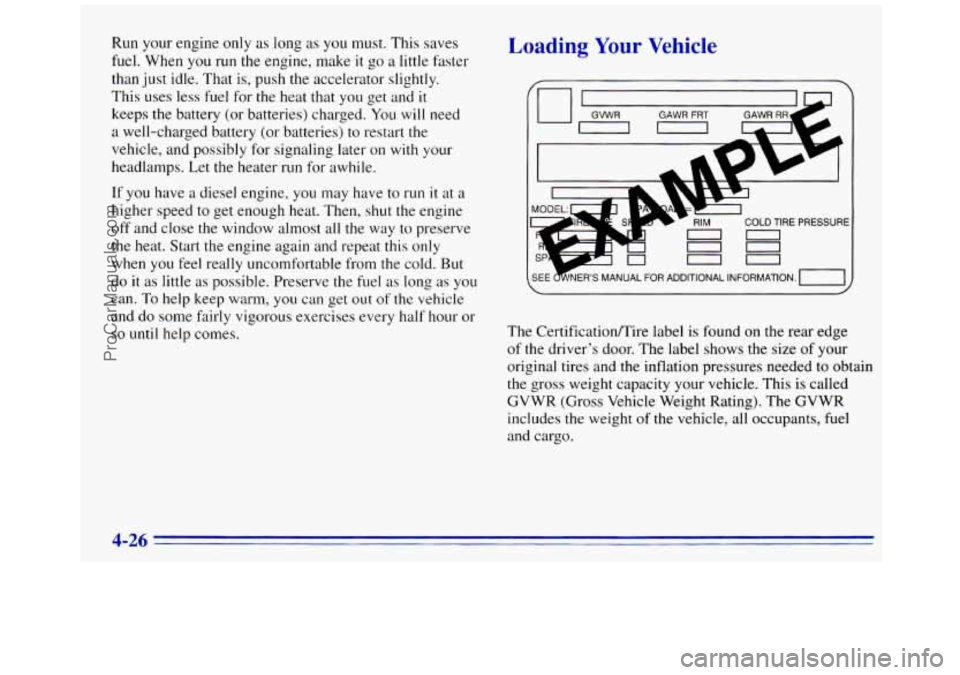
Run your engine only as long as you must. This saves
fuel. When you run the engine, make
it go a little fdster
than just idle. That
is, push the accelerator slightly.
This uses
less fuel for the heat that you get and it
keeps the battery (or batteries) charged. You will need
a well-charged battery (or batteries) to restart the
vehicle, and possibly for signaling later on with your
headlamps. Let the heater
run for awhile.
If you have a diesel engine, you may have to run it at a
higher speed to get enough heat. Then, shut the engine
off and close the window almost all the way to preserve
the heat. Start the engine again and repeat this only
when you feel really uncomfortable from the cold.
But
do it as little as possible. Preserve the fuel as long as you
can. To help keep warm, you can get out of the vehicle
and
do some fairly vigorous exercises every half hour or
so until help comes.
Loading Your T hicle
on
GAWR FRT
RIM COLD TIRE PRI
EE ~ENERS MANUAL FOR ADDITIONAL INFORMATION. -1
The CertificationRire label is found on the rear edge
of the driver’s door. The label shows the size
of your
original tires and the inflation pressures needed to obtain the gross weight capacity your vehicle. This is called
GVWR (Gross Vehicle Weight Rating). The GVWR
includes the weight of the vehicle, all occupants, fuel
and cargo.
4-26
ProCarManuals.com
Page 266 of 372
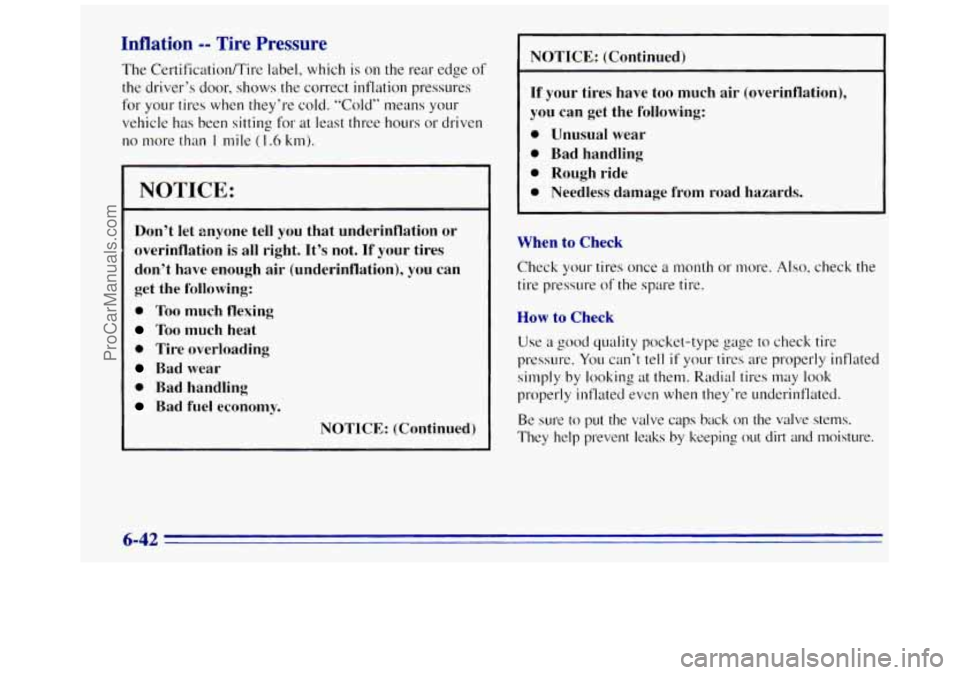
Inflation -- Tire Pressure
The Certification/Til-e-~ label, which is on the rear edge of
the driver’s door, shows the correct inflation pressures
for your tires when they’re cold. “Cold” means your
vehicle
has been sitting for at least three hours or driven
no 1mre than
1 mile (1.6 ktn).
NOTICE:
Don’t let anyone tell you that underinflation or
overinflation
is all right. It’s not. If your tires
don’t have enough air (underinflation), you can
get the following:
0 Too much flexing
Too much heat
0 Tire overloading
Bad wear
0 Bad handling
Bad fuel economy.
NOTICE: (Continued)
I NOTICE: (Continued) I
If your tires have too much air (overinflation),
you can get the following:
0 Unusual wear
0 Bad handling
0 Rough ride
0 Needless damage from road hazards.
When
to Check
Check your tires once a month or more.
Also, check the
tire pressure
of the spare tire.
Haw to Check
Use a
good quality pocket-type gage to check tire
pressure.
You can’t tell if yom tires are properly inflated
simply
by looking at them. Radial tires may look
properly inflated even
when they’re underinflated.
Be sure to put the valve caps back on the valve stems.
They help prevent leaks by keeping out dirt and moisture.
6-42
ProCarManuals.com
Page 267 of 372
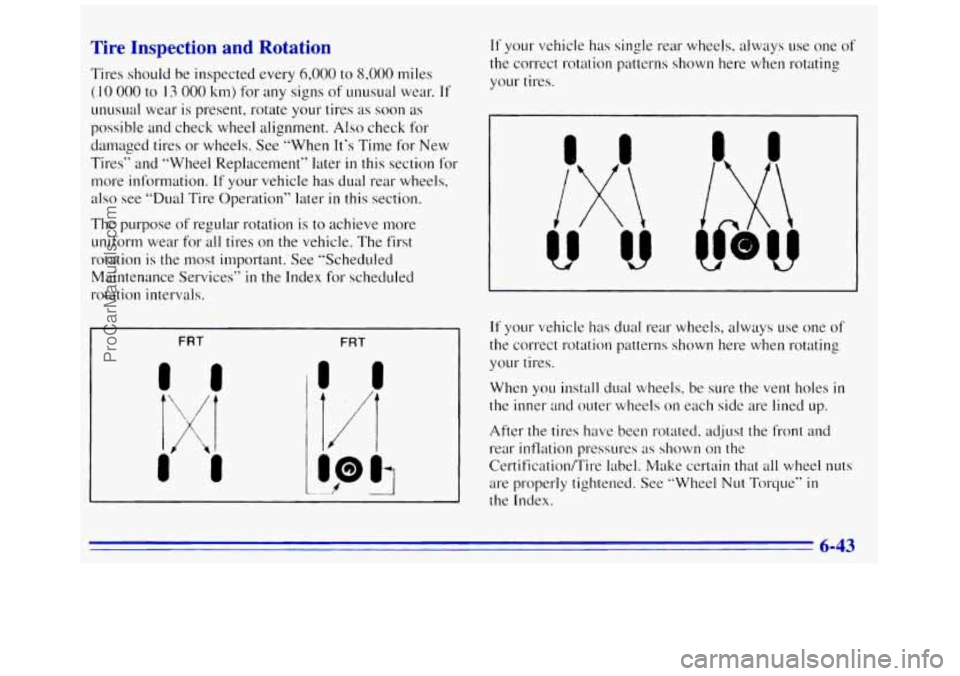
nspectior
1 Ires should be inspected every 6,000 to 8,000 miles
(I 0 000 to 13 000 km) for any signs of unusual wear. If
unusual wear is present, rotate your tires as soon as
possible and check wheel alignment. Also check for
damaged tires
or wheels. See “When It’s Time for New
Tires” and “Wheel Replacement” later
in this section for
more information.
If your vehicle has dual rear wheels,
also see “Dual Tire Operation“ later
in this section.
The purpose of regular rotation is to achieve more
uniform wear
for all tires on the vehicle. The first
rotation is the most important. See “Scheduled
Maintenance Services”
in the Index for scheduled
rotation intervals.
If your vehicle has single rear wheels, always use one of
the correct rotation patterns shown here when rotating
your tires.
If your vehicle has dual rear wheels, always use one of
FRT FRT the. correct rotation patterns shown here when rotating
KC
your tires.
When you install dual wheels, be sure the vent
holes in
the inner and outer wheels on each side are lined up.
After the tires have been rotated, adjust the front and
rear inflation pressures as shown on
the
CertificatidTire label. Make certain that all wheel nuts
are properly tightened. See “Wheel
Nut Torque” in
the Index.
6-43
ProCarManuals.com
Page 340 of 372
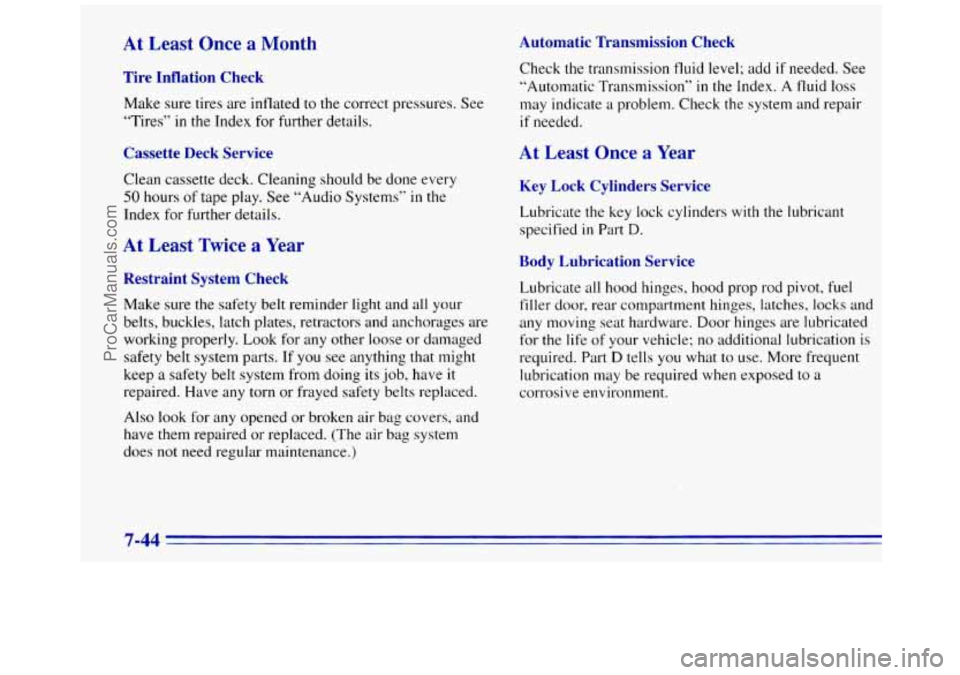
At Least Once a Month Automatic Transmission Check
Tire Inflation Check
Make sure tires are inflated to the correct pressures. See
“Tires”
in the Index for further details.
Cassettt -1eck Service
Clean cassette deck. Cleaning should be done every
50 hours of tape play. See “Audio Systems” in the
Index for further details.
At Least Twice a Year
Restraint System Check
Make sure the safety belt reminder light and all bur
belts, buckles, latch plates, retractorshnd anchoiages are
working properly.
Look for any other loose or damaged
safety belt system parts. If you see anything that might
keep
a safety belt system from doing its job, have it
repaired. Have any torn or frayed safety belts replaced.
Also look for any opened or broken air bag covers, and
have them repaired or replaced. (The air
bag system
does
not need regular maintenance.) Check
the transmission fluid level; add if needed. See
“Automatic Transmission“
in the Index. A fluid loss
may indicate a problem. Check the system and repair
if needed.
At Least Once a Year
Key Lock Cylinders Service
Lubricate the key lock cylinders with the lubricant
specified
in Part D.
Body Lubrication Service
Lubricate ail hood hinges, hood prop rod pivot, fuel
filler door, rear compartment hinges, latches,
locks and
any moving seat hardware. Door hinges are lubricated
for the
life of your vehicle; no additional lubrication is
required. Part D tells you what to use. More frequent
lubrication may be required when exposed to a
corrosive environment.
7-44
ProCarManuals.com
Page 369 of 372
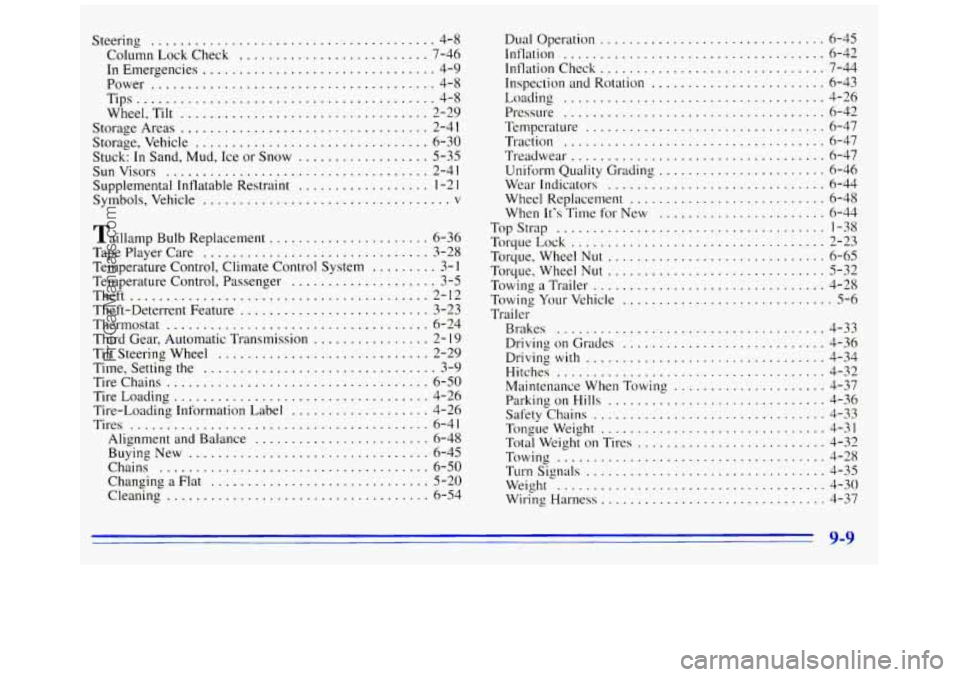
Steering ....................................... 4-8
Column Lock Check
.......................... 7-46
In Emergencies ................................ 4-9
Power
....................................... 4-8
Tips
......................................... 4-8
Wheel. Tilt
.................................. 2-29
Storage Areas
.................................. 2-41
Storage. Vehicle
................................ 6-30
Stuck:
In Sand. Mud. Ice or Snow .................. 5-35
Sunvisors
.................................... 2-41
Supplemental Inflatable Restraint
.................. 1-2 1
Symbols. Vehicle .................................. v
Taillamp Bulb Replacement ...................... 6-36
Tape Player Care
............................... 3-28
Temperature Control. Climate Control System
......... 3- 1
Temperature Control. Passenger .................... 3-5
Theft
......................................... 2-12
Theft-Deterrent Feature
.......................... 3-23
Thermostat
.................................... 6-24
Third Gear. Automatic Transmission
................ 2- I9
Tilt Steering Wheel ............................. 2-29
Time. Setting the
................................ 3-9
Tire Chains
.................................... 6-50
TireLoading ................................... 4-26
Tire-Loading Information Label
................... 4-26
Tires
......................................... 6- 41
Alignment and Balance
........................ 6-48
BuyingNew
................................. 6-45
Chains
..................................... 6-50
Changing
a Flat .............................. 5-20
Cleaning
.................................... 6-54 Dual Operation
............................... 6-45
Inflation
.................................... 6-42
Intlation Check
............................... 7-44
Inspection and Rotation
........................ 6-43
Loading
.................................... 4-26
Pressure
.................................... 6-42
Temperature
................................. 6-47
Traction
.................................... 6-47
Treadwear
................................... 6-47
Uniform Quality Grading
....................... 6-46
Wear Indicators
.............................. 6-44
Wheel Replacement
........................... 6-48
When It's Time for New
....................... 6-44
TorqueLock
................................... 2-23
Torque, Wheel
Nut .............................. 6-65
Torque, Wheel
Nut .............................. 5-32
Towing a Trailer
................................ 4-28
Towing Your Vehicle
............................. 5-6
Trailer Brakes
..................................... 4-33
Driving on Grades
............................ 4-36
Drivingwith
................................. 4-34
Hitches
..................................... 4-32
Maintenance When Towing
..................... 4-37
Parking on Hills
.............................. 4-36
Safety Chains
................................ 4-33
Tongueweight
............................... 4-31
Total Weight
on Tires .......................... 4-32
Towing
..................................... 4-28
Turn Slgnals
................................. 4-35
Weight
..................................... 4-30
Wiring Harness
............................... 4-37
TopStrap
..................................... 1-38
9-9
ProCarManuals.com